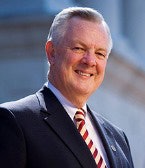 Sweet Briar College President Phillip C. Stone
Sweet Briar College President Phillip C. StoneSWEET BRIAR, Va. — Weeks into his presidency at Sweet Briar College, Phillip C. Stone still marvels at the energy of passionate alumnae who helped save the school just a few months ago from the fate of dozens of other women’s colleges: closure. But he knows that, without a serious change in fortune, the salvation will only be temporary.
The 72-year-old lawyer sat in his office this month as dozens of former students fanned over the 3,250-acre grounds in the foothills of the Blue Ridge Mountains to paint, pull weeds and mulch ahead before classes start Aug. 27.
“Our alumnae are really gassed up to help,” Stone said. “They are all over the campus.”
And they want to do more, he said.
“They want to help us recruit students, and we’re going to turn them loose,” Stone said, calling their pitch to prospective students “passion sales.”
But Stone admits the school’s long-term future will require more than just the fierce loyalty and the millions in donations that Sweet Briar women summoned to achieve a rare feat in higher education—saving a school from shutdown.
“The key is more students,” Stone said. “That’s going to be the heart of what we do.”
Sweet Briar’s leaders announced in March that the 114-year-old liberal arts college would close this month, buried by financial challenges deemed insurmountable. It was seen by many as another blow for private liberal arts colleges, especially women’s institutions. Of the 230 women’s colleges a half-century ago in the U.S., only 45 are still operating.
But the announcement was met with skepticism, anger and ultimately activism by former students who said they were blindsided by the news. They raised more than $21 million in pledges through June 19 to keep the college afloat and joined in lawsuits to blunt any move to shutter the campus.
Sweet Briar’s feel-good story is being watched closely in higher education circles. The school’s rescue is being celebrated as an inspiration for other suffering but scrappy liberal arts colleges, even as its long-term viability remains uncertain.
“A few months ago everyone worried that this was the canary in the coal mine,” said Richard Ekman, president of the Council of Independent Colleges. “Now I think the interest in Sweet Briar is that everyone is rooting for them to see if they can actually make it, given this new lease on life.”
Stone was tapped to lead Sweet Briar after a mediated settlement—announced over the Fourth of July holiday—to keep the school operating. His predecessor and the school’s governing board were swept out and new leaders brought in.
The settlement’s terms also called for several installments totaling $12 million by early September from Saving Sweet Briar Inc.—the nonprofit formed by alumnae—and freed some of the school’s healthy endowment, among other provisions.
Stone retired in 2010 as president of another private liberal arts school, Bridgewater College, which saw its enrollment more than double during his tenure, he said. Charming, courtly and avuncular, he now works in an office in transition, with a paucity of books scattered among the shelves.
In his few weeks at Sweet Briar, Stone has personally implored faculty members to stay, rehired workers who were let go by the previous administration, even brought in a new food service—basically hitting the restart button.
“I’ve done the interviewing. I’ve done the emails. I’ve done the thank you notes,” Stone said.
Faculty numbers are down to 95 from 125. With Sweet Briar’s future clouded for months, many looked elsewhere. Those who stayed served as the “closet administration,” said Linda Fink, who chairs the faculty executive committee.
“Nobody wanted to leave, but people had differing degrees of belief or disbelief that this was actually going to happen,” Fink said of Sweet Briar’s survival.
Stone acknowledges that many of the financial challenges his predecessor outlined in March have not gone away, and others have been added. Legal fees to battle the closing and the severance claims of workers who left total millions of dollars.
Moreover, the college’s endowment has been drawn down from approximately $90 million to $72 million, he said. He’s told faculty and departments to count on 80 percent of last year’s spending.
In addition, the freshman class is expected to number 50 of the approximately 300 students this fall. Stone says future enrollment has to grow to 800 to sustain Sweet Briar. Some 530 students—known as Vixens—were on campus last spring.
Stone sees potential students among the growing middle and upper middle classes in China and Arab nations, who can afford the tuition and fees totaling $47,000 annually.
“There are lots of families in a culture that protects young women and would find this a safe, beautiful place to go to school and get their American degree, which they treasure, and can pay the full freight,” Stone said.
Magnolia “Maggy” O’Donnell, an incoming sophomore from Sarasota, Florida, was accepted elsewhere but came back to Sweet Briar.
And next year?
“Honestly—and it’s very hard to say this without sounding Pollyannaish—I have no concern,” O’Donnell said.
To thrive, Sweet Briar will have to rely on families like the Adams clan from New London, New Hampshire, who joined the campus clean-up crew.
Park Adams, a corporate pilot, said his mother is a member of the Class of 1952, and he has no misgivings about his 16-year-old daughter, Katie, attending a school that had appeared finished. He said Sweet Briar’s alumnae-led rebirth has turned heads.
“I think next year it’s going to explode with applications,” Adams said. “Everyone is looking at this college.”
Ekman isn’t so sure but said it’s an inspirational story for higher education.
“If Sweet Briar makes it, and it looks as though this crisis has turned out well, that’s going to be reassuring to lots of other colleges,” he said.





















